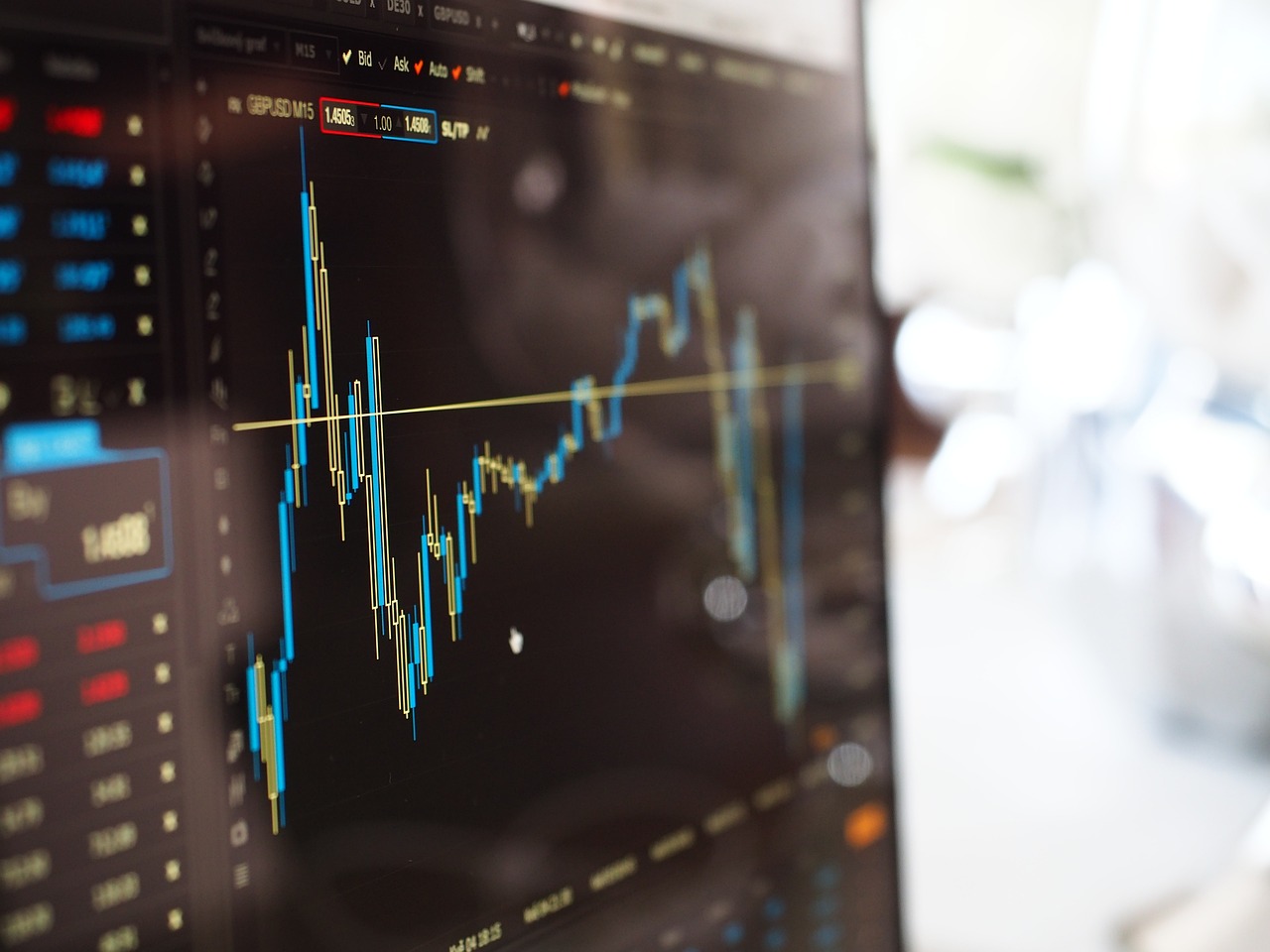The Basics of Swing Trading with Cryptocurrency
Welcome to the exciting world of swing trading in the cryptocurrency market! If you've ever been curious about how traders capitalize on short- to medium-term price fluctuations, you're in the right place. Swing trading is not just a buzzword; it’s a powerful strategy that can help you navigate the volatile waters of cryptocurrencies. Imagine catching a wave at just the right moment – that’s what swing trading is all about! By the end of this article, you’ll have a solid understanding of the fundamental principles of swing trading, along with insights on strategies, tools, and risk management techniques that can help you maximize your potential profits.
So, why should you consider swing trading over other methods like day trading or long-term investing? Well, swing trading strikes a balance between the two. Day trading requires constant monitoring and quick decision-making, which can be exhausting. On the other hand, long-term investing often involves waiting for years to see significant returns. Swing trading allows you to capitalize on price movements without the need to be glued to your screen all day. It’s like being a surfer who patiently waits for the perfect wave rather than paddling out every morning for an uncertain ride.
In the cryptocurrency market, where volatility reigns supreme, swing trading can be particularly advantageous. You can take advantage of price swings over days or weeks, which can lead to substantial gains. However, it’s essential to understand that with great potential rewards come inherent risks. That’s why having a solid grasp of swing trading principles, technical indicators, and risk management strategies is crucial. By the end of this article, you’ll not only know how to identify potential entry and exit points but also how to protect your capital effectively.
Are you ready to dive deeper into the world of swing trading? Let’s explore the core concepts that will set you on the path to becoming a proficient swing trader in the cryptocurrency landscape!
- What is swing trading? Swing trading is a trading strategy that aims to capture short- to medium-term price movements in assets, including cryptocurrencies.
- How does swing trading differ from day trading? Unlike day trading, which involves making multiple trades within a single day, swing trading focuses on holding positions for several days or weeks to take advantage of price swings.
- What are the key indicators used in swing trading? Common indicators include moving averages, the Relative Strength Index (RSI), and the Moving Average Convergence Divergence (MACD).
- How important is risk management in swing trading? Risk management is crucial in swing trading to protect your capital and minimize losses. Techniques include setting stop-loss orders and determining appropriate position sizes.

Understanding Swing Trading
Swing trading is a popular trading strategy that aims to capitalize on short- to medium-term price movements in various assets, particularly in the ever-evolving world of cryptocurrency. Unlike day trading, where traders buy and sell assets within the same day, or long-term investing, which involves holding assets for extended periods, swing trading falls somewhere in the middle. It allows traders to take advantage of price fluctuations over several days or weeks, making it an appealing option for those who cannot monitor their trades constantly.
One of the key advantages of swing trading is its ability to combine the benefits of both short-term and long-term strategies. Traders can enjoy the thrill of quick profits while still having the flexibility to analyze market trends over a slightly longer timeframe. This approach can be particularly beneficial in the highly volatile cryptocurrency market, where prices can swing dramatically within short periods.
To better understand swing trading, it's essential to recognize how it differs from other trading strategies. Here’s a quick breakdown:
| Trading Strategy | Timeframe | Focus | Risk Level |
|---|---|---|---|
| Swing Trading | Days to Weeks | Short to Medium-Term Price Movements | Moderate |
| Day Trading | Minutes to Hours | Intraday Price Fluctuations | High |
| Long-Term Investing | Months to Years | Fundamental Value | Low |
In swing trading, traders often rely on technical analysis to identify potential entry and exit points. This involves using various indicators and chart patterns to predict future price movements based on historical data. The goal is to enter a trade at a lower price and exit at a higher price, thus capturing the 'swing' in price movements. By focusing on the short to medium-term, swing traders can react to market changes and adjust their strategies accordingly.
Moreover, swing trading is not just about making quick profits; it also requires a solid understanding of market trends and the ability to manage risks effectively. This means that swing traders must be disciplined, patient, and willing to continuously learn and adapt to the market dynamics. With the right strategies and tools, anyone can become a successful swing trader in the cryptocurrency market.

Key Indicators for Swing Trading
When it comes to swing trading in the cryptocurrency market, understanding and utilizing key indicators can be the difference between a profitable trade and a costly mistake. These indicators serve as essential tools that help traders make informed decisions based on market trends and price movements. By analyzing these metrics, traders can identify potential entry and exit points, allowing them to capitalize on short- to medium-term price fluctuations.
Among the most vital indicators for swing trading are Moving Averages, Relative Strength Index (RSI), and Moving Average Convergence Divergence (MACD). Each of these tools provides unique insights into market behavior, and when used together, they can create a comprehensive trading strategy.
Let’s break down these indicators further to understand their significance:
Moving averages are a fundamental component of technical analysis. They help smooth out price data over a specified period, allowing traders to identify trends more clearly. There are two main types of moving averages that swing traders often rely on:
- Simple Moving Average (SMA): This is the average price of an asset over a specific number of periods. It’s calculated by summing the closing prices over a defined period and then dividing by the number of periods.
- Exponential Moving Average (EMA): Unlike the SMA, the EMA gives more weight to recent prices, making it more responsive to new information. This can be particularly useful for swing traders looking to make quick decisions.
Both types of moving averages can help traders identify bullish or bearish trends, which is critical for making timely trading decisions.
The Simple Moving Average (SMA) is often the go-to choice for many traders due to its simplicity and effectiveness. To calculate the SMA, you simply add up the closing prices for a set number of periods and divide by that number. For example, if you are looking at a 10-day SMA, you would take the closing prices for the last 10 days, add them together, and divide by 10. The resulting value can then be plotted on a chart, allowing traders to visualize trends over time.
The Exponential Moving Average (EMA) is favored by many swing traders because it reacts more swiftly to price changes compared to the SMA. This characteristic allows traders to spot potential reversals and trends much quicker. The EMA is calculated using a formula that applies a multiplier to the most recent price, which means that the latest data points have a greater influence on the average. By incorporating the EMA into their trading strategy, traders can make more informed decisions about when to enter or exit trades.
The Relative Strength Index (RSI) is a momentum oscillator that measures the speed and change of price movements. It ranges from 0 to 100 and is typically used to identify overbought or oversold conditions in a market. An RSI reading above 70 often indicates that an asset is overbought, while a reading below 30 suggests it is oversold. This information can be incredibly valuable for swing traders, as it helps them gauge market sentiment and potential price reversals.
By combining these indicators—Moving Averages to identify trends and RSI to assess momentum—traders can create a robust swing trading strategy that maximizes their chances of success. However, it's important to remember that no indicator is foolproof. Market conditions can change rapidly, and it's crucial to adapt your strategy accordingly.
- What is the best time frame for swing trading? Swing traders typically look at time frames ranging from 1 hour to daily charts, as these provide a balance between capturing short-term movements and avoiding excessive noise.
- How much capital do I need to start swing trading? The amount of capital required can vary, but many traders start with a few hundred dollars. It's essential to only trade with money you can afford to lose.
- Can I swing trade without using indicators? While it’s possible to swing trade without indicators, using them can significantly improve your chances of success by providing valuable insights into market trends.

Moving Averages
When it comes to swing trading, are like the trusty compass that guides you through the often turbulent waters of the cryptocurrency market. They help traders smooth out price fluctuations and identify the underlying trends that can make or break their trading strategy. Essentially, moving averages provide a clearer picture of price movements over a specific period, allowing traders to make more informed decisions.
There are two primary types of moving averages that every swing trader should be familiar with: the Simple Moving Average (SMA) and the Exponential Moving Average (EMA). Each type has its unique characteristics and applications, which can significantly impact your trading strategy.
The Simple Moving Average (SMA) is calculated by taking the average of a set number of closing prices over a specific time frame. For instance, a 10-day SMA would average the closing prices of the last ten days. This method is straightforward and provides a solid foundation for understanding price trends. However, it can be slow to react to sudden price changes, which can be a disadvantage in the fast-paced world of cryptocurrency.
On the other hand, the Exponential Moving Average (EMA) gives more weight to recent prices, making it more responsive to new information. This characteristic can be particularly beneficial for swing traders who need to make quick decisions based on the latest market movements. For example, if a cryptocurrency is experiencing a rapid increase in price, the EMA will reflect this change more swiftly than the SMA, potentially signaling a buy opportunity.
To illustrate the differences between these two types of moving averages, consider the following table:
| Feature | Simple Moving Average (SMA) | Exponential Moving Average (EMA) |
|---|---|---|
| Calculation Method | Average of closing prices over a specific period | Weighted average that gives more importance to recent prices |
| Responsiveness | Slower to react to price changes | Faster to respond to recent price movements |
| Best Used For | Identifying long-term trends | Spotting short-term price movements |
In summary, moving averages are an invaluable tool for swing traders looking to capitalize on price fluctuations in the cryptocurrency market. By understanding the differences between SMA and EMA, traders can choose the right moving average to suit their trading style and objectives. Whether you prefer the simplicity of the SMA or the responsiveness of the EMA, incorporating moving averages into your trading strategy can significantly enhance your ability to identify potential entry and exit points.
- What is the best moving average for swing trading? The best moving average often depends on your trading style. Many traders use a combination of both SMA and EMA to get a comprehensive view of market trends.
- How do I set up moving averages on my trading platform? Most trading platforms have built-in tools for adding moving averages to your charts. Simply select the moving average option and specify the time period you wish to analyze.
- Can moving averages guarantee profits in trading? While moving averages are helpful tools for identifying trends, they do not guarantee profits. It's essential to use them in conjunction with other indicators and risk management strategies.

Simple Moving Average (SMA)
The is a fundamental tool in the arsenal of any swing trader. It serves as a basic yet powerful indicator that helps traders identify the direction of the trend by smoothing out price data over a specified period. Imagine trying to read a book with a flickering light; the words can be hard to see. Similarly, the SMA illuminates the price movements, allowing traders to see the underlying trends more clearly.
To calculate the SMA, you simply take the average of the closing prices over a specific number of periods. For example, if you are looking at a 10-day SMA, you would add the closing prices of the last 10 days and then divide that total by 10. This calculation can be visualized as follows:
| Day | Closing Price |
|---|---|
| 1 | $100 |
| 2 | $105 |
| 3 | $102 |
| 4 | $107 |
| 5 | $110 |
| 6 | $108 |
| 7 | $111 |
| 8 | $115 |
| 9 | $120 |
| 10 | $125 |
In this example, to find the 10-day SMA, you would add all the closing prices together and divide by 10, resulting in an average that helps you see the trend over that period. The SMA is particularly useful in swing trading because it allows traders to identify potential buy or sell signals based on the crossover of the price and the SMA line. When the price crosses above the SMA, it can indicate a potential buying opportunity, while a crossover below the SMA can signal a selling opportunity.
One of the significant advantages of the SMA is its simplicity. However, it’s essential to understand that while it provides a clear view of the trend, it can lag behind the price action, especially in volatile markets like cryptocurrency. This lag can sometimes lead to missed opportunities. Therefore, savvy traders often combine the SMA with other indicators, such as the Exponential Moving Average (EMA) or the Relative Strength Index (RSI), to enhance their decision-making process.
In conclusion, the Simple Moving Average is a vital tool for swing traders, offering insights into market trends and potential trading opportunities. By understanding how to calculate and interpret the SMA, traders can make informed decisions, thereby increasing their chances of success in the fast-paced world of cryptocurrency trading.
- What is the best period for the SMA? The best period depends on your trading strategy. Shorter periods (like 10 or 20 days) are more responsive to price changes, while longer periods (like 50 or 200 days) provide a smoother trend line.
- Can I use SMA for day trading? Yes, many day traders use SMA to identify short-term trends and potential entry and exit points.
- How does SMA differ from EMA? The EMA gives more weight to recent prices, making it more responsive to price changes compared to the SMA.

Exponential Moving Average (EMA)
The is a powerful tool that many traders swear by when it comes to swing trading in the cryptocurrency market. Unlike the Simple Moving Average (SMA), which gives equal weight to all price points over a specified period, the EMA gives more importance to recent prices. This unique characteristic makes the EMA more responsive to price changes, allowing traders to detect potential trends earlier. Imagine trying to catch a wave; the EMA helps you spot the swell before it breaks, giving you the advantage to ride it successfully.
Calculating the EMA involves a bit of math, but don’t worry; it’s not as daunting as it sounds! The formula incorporates the previous EMA value and the current price, which means that each new price point influences the EMA more significantly than older prices. This is particularly useful in the fast-paced world of cryptocurrencies, where price fluctuations can happen in the blink of an eye. To put it simply, the EMA acts like a spotlight, illuminating the most relevant price movements while fading out the noise from the past.
One of the biggest advantages of using the EMA in swing trading is its ability to signal potential buy or sell opportunities. Traders often look for crossovers between the EMA and the price line or other moving averages. For instance, when the price crosses above the EMA, it can indicate a buying opportunity, while a crossover below can suggest it’s time to sell. This dynamic interaction creates a visual cue that traders can easily interpret, making decision-making less stressful and more intuitive.
Here’s a quick breakdown of how the EMA can enhance your trading strategy:
- Trend Identification: The EMA helps in identifying the direction of the trend, allowing traders to align their trades accordingly.
- Signal Generation: Crossovers can serve as buy or sell signals, providing clear entry and exit points.
- Market Volatility Adaptation: The EMA's responsiveness allows traders to adapt quickly to market volatility, which is crucial in the crypto world.
In conclusion, integrating the EMA into your swing trading strategy can provide significant advantages. By focusing on recent price data, the EMA helps traders make informed decisions quickly, allowing them to capitalize on short- to medium-term price movements. So, if you’re looking to enhance your trading game, consider giving the EMA a try—it might just be the edge you need in the ever-evolving cryptocurrency market.

Relative Strength Index (RSI)
The is a powerful tool in the arsenal of swing traders, acting as a momentum oscillator that measures the speed and change of price movements. Think of it as a compass that helps traders navigate the often tumultuous waters of the cryptocurrency market. By providing insights into whether an asset is overbought or oversold, the RSI can guide traders in making informed decisions about when to enter or exit a trade.
Typically, the RSI is displayed on a scale of 0 to 100. A reading above 70 usually indicates that an asset is overbought, suggesting that it may be due for a price correction. Conversely, a reading below 30 signals that the asset is oversold, which might present a buying opportunity. This dynamic nature of the RSI makes it an essential indicator for swing traders looking to capitalize on short-term price fluctuations.
To interpret RSI readings effectively, traders often look for divergences between the RSI and the price action of the asset. For instance, if the price of a cryptocurrency is making new highs while the RSI is failing to do so, this could indicate a potential reversal. Such divergences can serve as early warning signs, alerting traders to possible shifts in market sentiment. It's like having a radar that helps you detect impending storms before they hit.
Another important aspect of using the RSI is understanding its time frame. While many traders use the default 14-period setting, adjusting this can yield different insights. A shorter time frame, such as 7 periods, can make the RSI more sensitive, providing quicker signals but also increasing the risk of false alarms. On the other hand, a longer time frame, like 21 periods, smooths out the fluctuations, offering a more stable reading but potentially missing out on shorter-term opportunities. Finding the right balance is key to leveraging the RSI effectively in your swing trading strategy.
In summary, the RSI is not just another technical indicator; it's a vital part of a swing trader's toolkit. By understanding how to read and interpret RSI values, traders can enhance their decision-making process and improve their chances of success in the fast-paced world of cryptocurrency trading. As with any tool, practice and experience will help you use the RSI to its full potential, turning it into a reliable guide on your trading journey.
- What is the best RSI setting for swing trading? While the default setting is 14 periods, many traders experiment with different settings based on their trading style and the asset being traded.
- How do I use RSI in conjunction with other indicators? Combining RSI with other indicators like moving averages or MACD can provide a more comprehensive view of market conditions and improve trading strategies.
- Can RSI be used for all cryptocurrencies? Yes, RSI can be applied to any cryptocurrency, but its effectiveness may vary based on market conditions and the specific asset's volatility.

Risk Management in Swing Trading
In the exhilarating world of swing trading, where fortunes can change in the blink of an eye, effective risk management is your best friend. Think of it as your safety net, ensuring that when the market takes a nosedive, you don't fall flat on your face. But what exactly does risk management entail in the context of swing trading? Well, it's all about protecting your capital and making sure that your trading journey is as smooth as possible.
One of the most crucial aspects of risk management is setting stop-loss orders. These are like your personal bodyguards in the trading arena. A stop-loss order automatically sells your asset when it reaches a certain price, limiting your potential losses. For instance, if you buy a cryptocurrency at $100 and set a stop-loss at $90, your investment will sell if the price drops to $90, protecting you from further losses. The key here is to determine a stop-loss level that makes sense for your trading strategy and risk tolerance. It’s essential to strike a balance; set it too tight, and you might get stopped out of a good trade, but set it too loose, and you risk larger losses.
Another vital component of risk management is position sizing. This refers to how much of your capital you allocate to a single trade. Imagine you have a portfolio of $10,000 and you decide that you’re willing to risk 1% of your capital on any given trade. This means that your maximum risk is $100. If your stop-loss is set at a level that would incur a loss of $50, you could comfortably buy $1,000 worth of the cryptocurrency. Understanding position sizing helps you avoid the pitfall of over-leveraging your trades, which can lead to catastrophic losses.
To put it simply, you want to ensure that your trading strategy is sustainable in the long run. Here’s a quick table summarizing the key elements of risk management:
| Risk Management Element | Description |
|---|---|
| Stop-Loss Orders | Automatically sells an asset at a predetermined price to limit losses. |
| Position Sizing | Determines how much capital to allocate to each trade based on risk tolerance. |
| Diversification | Spreading investments across different assets to reduce risk. |
Lastly, let’s not forget about diversification. Just like you wouldn’t put all your eggs in one basket, you shouldn’t invest all your capital in a single cryptocurrency. By diversifying your portfolio, you can mitigate risks associated with individual assets. For example, if one asset plummets, the others in your portfolio might still perform well, cushioning the blow. Aim to have a mix of different cryptocurrencies and perhaps even other asset classes to create a more balanced portfolio.
In conclusion, mastering risk management in swing trading is not just about avoiding losses; it’s about creating a robust strategy that allows you to trade with confidence. By setting effective stop-loss orders, understanding position sizing, and diversifying your investments, you can navigate the volatile waters of the cryptocurrency market with greater ease and less stress.
- What is the purpose of a stop-loss order? A stop-loss order helps limit potential losses by automatically selling an asset when it reaches a specified price.
- How do I determine my position size? Position size can be calculated by determining the amount of capital you are willing to risk on a trade and dividing it by the distance of your stop-loss from the entry price.
- Is diversification really necessary? Yes, diversification helps to spread risk across different assets, reducing the impact of a poor-performing investment on your overall portfolio.

Setting Stop-Loss Orders
When it comes to swing trading, one of the most critical strategies for protecting your investments is setting stop-loss orders. A stop-loss order is essentially a safety net that automatically sells your cryptocurrency when it reaches a certain price, helping you limit your losses in a volatile market. Imagine you’ve bought Bitcoin at $50,000, and you want to ensure that you don’t lose more than 10% of your investment. By setting a stop-loss order at $45,000, you can sleep easier knowing that if the market takes a downturn, your assets will be sold before your losses escalate.
But how do you effectively set these stop-loss orders? First, you need to consider your overall trading strategy and risk tolerance. A common rule of thumb is to set your stop-loss order at a level that reflects your risk appetite. For instance, if you’re comfortable with a 5% loss, that’s where you’d place your stop-loss. This approach allows you to maintain control over your capital while still engaging in the market's ups and downs.
Here are some essential factors to consider when setting your stop-loss orders:
- Market Volatility: Cryptocurrencies are notoriously volatile. A stop-loss set too close to your entry price might trigger too soon during normal price fluctuations.
- Support and Resistance Levels: Analyze the price chart to identify key support and resistance levels. Setting your stop-loss just below a support level can provide a buffer against minor dips.
- Timeframe: The timeframe of your trades matters. For swing trading, a stop-loss might be set differently compared to day trading or long-term investing.
It's also important to remember that while stop-loss orders are a great tool, they are not foolproof. In extremely volatile markets, prices can gap down, meaning your stop-loss order might execute at a lower price than expected. This phenomenon is known as slippage, and it can be detrimental to your trading strategy. Therefore, always combine stop-loss orders with other risk management techniques, like position sizing and diversification, to create a robust trading plan.
In conclusion, setting stop-loss orders is a fundamental aspect of swing trading that can significantly mitigate risks. By understanding the market, analyzing support and resistance levels, and considering your risk tolerance, you can effectively protect your investments and navigate the volatile waters of cryptocurrency trading.
1. What is a stop-loss order?
A stop-loss order is an order placed with a broker to buy or sell once the stock reaches a certain price, designed to limit an investor's loss on a position.
2. How do I set a stop-loss order?
To set a stop-loss order, determine your risk tolerance, analyze market conditions, and place the order at a price point that reflects your strategy.
3. Can stop-loss orders guarantee that I won't lose money?
No, while stop-loss orders help limit losses, they cannot guarantee profits or prevent losses in highly volatile markets due to slippage.
4. Should I use a fixed or trailing stop-loss?
This depends on your trading strategy. A fixed stop-loss is set at a specific price, while a trailing stop-loss adjusts as the price moves in your favor, locking in profits.

Position Sizing Strategies
When it comes to swing trading, position sizing is one of the most critical aspects that can determine your success or failure in the market. Think of it as the foundation of your trading strategy; without a solid base, everything else can crumble. Position sizing refers to the amount of capital you allocate to a specific trade, and getting this right can help you manage risk effectively while maximizing your potential profits.
One popular method of position sizing is the fixed dollar amount strategy. In this approach, a trader decides on a specific dollar amount to risk on each trade, say $100. This means that regardless of the size of your trading account, you will consistently risk the same amount on every trade. While this method is straightforward, it doesn't take into account the volatility of the asset being traded. For instance, if you’re trading a highly volatile cryptocurrency, risking a fixed dollar amount might expose you to larger losses than you can afford.
Another effective strategy is the percentage of account equity method. With this approach, you determine a percentage of your total trading capital to risk on each trade. For example, if you decide to risk 2% of your account on a trade and your account balance is $10,000, you would risk $200. This method adjusts your risk based on your total account size, which can be beneficial as your account grows or shrinks. However, it’s essential to remain disciplined and not exceed your predetermined percentage, as emotional decisions can lead to significant losses.
To further refine your position sizing, consider using the Kelly Criterion. This formula helps you determine the optimal size of your bets based on your win rate and the ratio of your average win to your average loss. While this might sound complex, it can provide valuable insights into how much capital to allocate to each trade. By calculating your optimal position size, you can maximize your growth potential while minimizing the risk of ruin.
Here’s a quick comparison of the three position sizing strategies:
| Strategy | Description | Pros | Cons |
|---|---|---|---|
| Fixed Dollar Amount | Risk a consistent dollar amount for each trade. | Simple and easy to implement. | Doesn’t account for asset volatility. |
| Percentage of Account Equity | Risk a percentage of total account value on each trade. | Adjusts risk based on account size. | Requires discipline to stick to the percentage. |
| Kelly Criterion | Calculates optimal bet size based on win rate and payout ratio. | Maximizes growth potential. | Complex and may require adjustments over time. |
In summary, the way you approach position sizing can significantly impact your trading journey. Whether you choose a fixed dollar amount, a percentage of account equity, or the Kelly Criterion, the key is to stay disciplined and stick to your plan. Remember, it’s not just about how much you can make, but also about how much you can afford to lose. The right position sizing strategy will help you navigate the unpredictable waters of swing trading with confidence.
- What is position sizing? Position sizing is determining how much capital to allocate to a specific trade based on your risk tolerance and trading strategy.
- Why is position sizing important in swing trading? Proper position sizing helps manage risk, protects your capital, and can enhance your overall trading performance.
- How do I determine my position size? You can use methods such as fixed dollar amount, percentage of account equity, or the Kelly Criterion to calculate your position size.
- What happens if I don’t use a position sizing strategy? Without a position sizing strategy, you risk overexposing your capital to losses, which can lead to significant financial setbacks.

Tools and Platforms for Swing Trading
When it comes to swing trading in the cryptocurrency market, the right tools and platforms can make all the difference in your trading experience. Imagine trying to navigate a complex maze without a map; that’s what trading without the right tools feels like. You need reliable platforms that not only allow you to execute trades but also provide you with analytical tools to make informed decisions. So, let’s dive into the essentials!
First off, you need a solid trading platform. There are numerous options available, each boasting unique features tailored to different trading styles. Some platforms are user-friendly and great for beginners, while others offer advanced tools for seasoned traders. Here’s a quick comparison of some popular platforms:
| Platform | Features | Best For |
|---|---|---|
| Binance | Wide range of cryptocurrencies, advanced charting tools, low fees | Experienced traders |
| Coinbase Pro | User-friendly interface, strong security, advanced trading options | Beginners and intermediate traders |
| Kraken | Robust security, margin trading, futures trading | Advanced traders |
| eToro | Social trading features, user-friendly interface, demo account | Social traders and beginners |
Next, let’s talk about charting tools. These are absolutely essential for technical analysis, allowing you to visualize price movements and identify trends. Good charting software can provide you with indicators, overlays, and drawing tools to enhance your analysis. Some of the best charting tools for cryptocurrency swing traders include:
- TradingView: Known for its extensive features and community-driven insights, TradingView is a favorite among traders for its customizable charts and social trading capabilities.
- CryptoCompare: This platform offers comprehensive data and charting tools, making it easier to compare different cryptocurrencies and their performance.
- Coinigy: A powerful tool that integrates with multiple exchanges, Coinigy provides real-time data and advanced charting options, perfect for swing traders looking to capitalize on market movements.
Moreover, many of these platforms come equipped with mobile applications, allowing you to monitor your trades on the go. Imagine being able to check your portfolio while sipping coffee at your favorite café or making a quick trade while waiting for a friend. This flexibility is invaluable in the fast-paced world of cryptocurrency trading.
Lastly, don’t forget about the importance of security when choosing a trading platform. With the rise of cyber threats, ensuring that the platform you choose has robust security measures is crucial. Look for features such as two-factor authentication, cold storage for funds, and a solid reputation in the trading community.
In summary, the tools and platforms you choose for swing trading can significantly impact your trading success. By selecting a platform that aligns with your trading style and utilizing effective charting tools, you can enhance your ability to make informed decisions and maximize your profits. Remember, in the world of cryptocurrency, having the right tools is like having a sturdy compass in uncharted territory!
Q: What is swing trading?
A: Swing trading is a trading strategy that aims to capture short- to medium-term price movements in assets, typically holding positions for several days to weeks.
Q: How do I choose the right trading platform?
A: Consider factors such as fees, user interface, available cryptocurrencies, security features, and whether the platform offers the tools you need for your trading strategy.
Q: What are the key indicators for swing trading?
A: Important indicators include moving averages, Relative Strength Index (RSI), and Moving Average Convergence Divergence (MACD), which help traders identify potential entry and exit points.
Q: How can I manage risk in swing trading?
A: You can manage risk by setting stop-loss orders, determining position sizes based on your risk tolerance, and diversifying your investments.

Trading Platforms
When it comes to swing trading in the cryptocurrency market, the choice of trading platform can significantly influence your overall success. A good trading platform not only provides a user-friendly interface but also comes equipped with various features that cater specifically to the needs of swing traders. Imagine trying to navigate a complex maze without a map; that’s what trading can feel like without the right platform. So, let’s dive into some of the top platforms available, and what makes each one unique.
One of the critical aspects of a trading platform is its usability. You want something that feels intuitive right from the get-go. Some platforms, like Binance and Coinbase Pro, offer a straightforward interface that even beginners can grasp quickly. Meanwhile, others, such as Kraken, provide advanced trading tools that might be overwhelming for newcomers but are incredibly beneficial for seasoned traders. The key is to find a balance that suits your trading style and experience level.
Another vital feature is the availability of technical analysis tools. Swing traders rely heavily on charts and indicators to make informed decisions. Platforms like TradingView are renowned for their advanced charting capabilities, allowing traders to customize their indicators and set alerts for specific price movements. This can be a game-changer when you’re trying to catch those fleeting opportunities in the market.
Moreover, the fees associated with trading can vary significantly from one platform to another. Some platforms charge a flat fee per trade, while others may take a percentage of the transaction. It’s essential to consider how these fees will impact your overall profitability, especially in swing trading where multiple trades may be executed within a short period. Here’s a quick comparison of some popular platforms:
| Platform | Trading Fees | Features |
|---|---|---|
| Binance | 0.1% per trade | Advanced tools, low fees, high liquidity |
| Coinbase Pro | 0.5% - 1.5% based on volume | User-friendly, robust security, advanced charting |
| Kraken | 0.16% - 0.26% | Wide variety of coins, margin trading, staking |
| TradingView | Varies by broker | Advanced charting, social features, customizable alerts |
Lastly, let’s not forget about customer support. In the fast-paced world of cryptocurrency trading, having access to reliable customer service can be a lifesaver. Whether you encounter a technical issue or need clarification on a fee structure, responsive support can make all the difference. Platforms like Binance and Kraken are known for their robust support systems, offering live chat options that can help you resolve issues quickly.
In conclusion, choosing the right trading platform for swing trading in cryptocurrency is a decision that should not be taken lightly. Consider factors such as usability, technical analysis tools, fees, and customer support to find a platform that aligns with your trading goals. After all, a well-equipped trader is a successful trader!
1. What is swing trading in cryptocurrency?
Swing trading is a trading strategy that aims to capture short- to medium-term price movements in cryptocurrencies, typically holding positions for several days to weeks.
2. How do I choose the best trading platform?
When choosing a trading platform, consider usability, fees, available tools for technical analysis, and customer support to ensure it meets your trading needs.
3. What are the risks of swing trading?
The primary risks include market volatility, potential losses from incorrect trades, and the emotional stress of managing trades over a period of time.
4. Can I swing trade on my mobile device?
Yes, many trading platforms offer mobile applications that allow you to trade on the go, making it easier to manage your positions wherever you are.

Charting Tools
When it comes to swing trading in the cryptocurrency market, having the right at your disposal can make all the difference. These tools not only help you visualize price movements but also enable you to make informed decisions based on technical analysis. Imagine trying to navigate a ship without a compass; that's what trading without proper charting tools feels like!
There are numerous charting tools available, each offering unique features that cater to different trading styles. Some platforms focus on simplicity, while others provide advanced functionalities for seasoned traders. Here are a few popular charting tools that can significantly enhance your swing trading experience:
| Charting Tool | Key Features | Best For |
|---|---|---|
| TradingView | Customizable charts, social network, multiple indicators | All levels of traders |
| Coinigy | Real-time data, trading across multiple exchanges, portfolio management | Active traders |
| Cryptowat.ch | Live price charts, market data, alerts | Quick analysis |
Each of these tools has its strengths. For example, TradingView is popular for its user-friendly interface and extensive community features, allowing traders to share ideas and strategies. On the other hand, Coinigy stands out for its ability to manage trades across various exchanges, making it ideal for those who like to diversify their trading activities.
Moreover, charting tools often come equipped with a variety of technical indicators that are essential for swing trading. Indicators such as moving averages, RSI, and MACD can be easily integrated into your charts, providing you with vital insights into market trends and potential reversal points. The ability to overlay these indicators on your charts allows you to see the bigger picture and helps you make more educated trading decisions.
In addition to standard charting capabilities, many platforms now offer mobile applications, allowing traders to monitor their positions and make trades on the go. This flexibility is particularly beneficial for swing traders, who may need to react quickly to sudden market movements. Just like a bird must be ready to take flight at any moment, swing traders must stay alert to seize opportunities.
Ultimately, the choice of charting tool will depend on your individual trading needs and preferences. It's worth taking the time to explore different options and find a platform that resonates with your trading style. Remember, the right tool can empower you to make better decisions and improve your overall trading performance!
- What are charting tools? Charting tools are software applications that allow traders to visualize price movements and analyze market trends through various chart types and indicators.
- Do I need advanced charting tools for swing trading? While advanced tools can provide additional insights, many successful swing traders use basic charting tools effectively. It ultimately depends on your trading strategy and comfort level.
- Can I use charting tools on my mobile device? Yes, many modern charting platforms offer mobile applications, enabling you to trade and analyze markets from anywhere.
Frequently Asked Questions
- What is swing trading in cryptocurrency?
Swing trading in cryptocurrency is a strategy that focuses on capturing short- to medium-term price movements. Unlike day trading, where positions are held for a single day, swing traders typically hold their assets for several days to weeks, aiming to profit from price swings.
- How do I identify good entry and exit points for swing trading?
To identify entry and exit points, traders often rely on technical indicators such as moving averages, Relative Strength Index (RSI), and MACD. These tools help analyze price trends and momentum, guiding traders on when to buy or sell.
- What is the difference between Simple Moving Average (SMA) and Exponential Moving Average (EMA)?
The Simple Moving Average (SMA) calculates the average price over a specific period, giving equal weight to all prices. In contrast, the Exponential Moving Average (EMA) gives more weight to recent prices, making it more responsive to new information. This can be particularly useful for swing traders looking to make timely decisions.
- How can I manage risks while swing trading?
Risk management is crucial in swing trading. Setting stop-loss orders can help limit potential losses by automatically selling assets at a predetermined price. Additionally, employing position sizing strategies allows traders to allocate their capital wisely based on their risk tolerance and account size.
- What trading platforms are best for swing trading cryptocurrencies?
Several trading platforms cater specifically to swing traders in the cryptocurrency market. Popular options include Binance, Coinbase Pro, and Kraken. Each platform offers unique features, so it’s essential to choose one that aligns with your trading needs and preferences.
- Do I need advanced technical skills to start swing trading?
While having a basic understanding of technical analysis is beneficial, you don’t need to be an expert to start swing trading. Many resources are available online to help you learn the basics of charting and indicators, making it accessible for beginners.
- How long should I hold a position in swing trading?
The duration for holding a position in swing trading can vary significantly based on market conditions and individual strategies. Generally, traders hold positions anywhere from a few days to several weeks, depending on the price movements they anticipate.
- What are the common mistakes to avoid in swing trading?
Some common mistakes in swing trading include failing to set stop-loss orders, over-leveraging, and not conducting proper research before entering trades. It’s essential to stay disciplined, stick to your strategy, and continuously educate yourself to avoid these pitfalls.



















